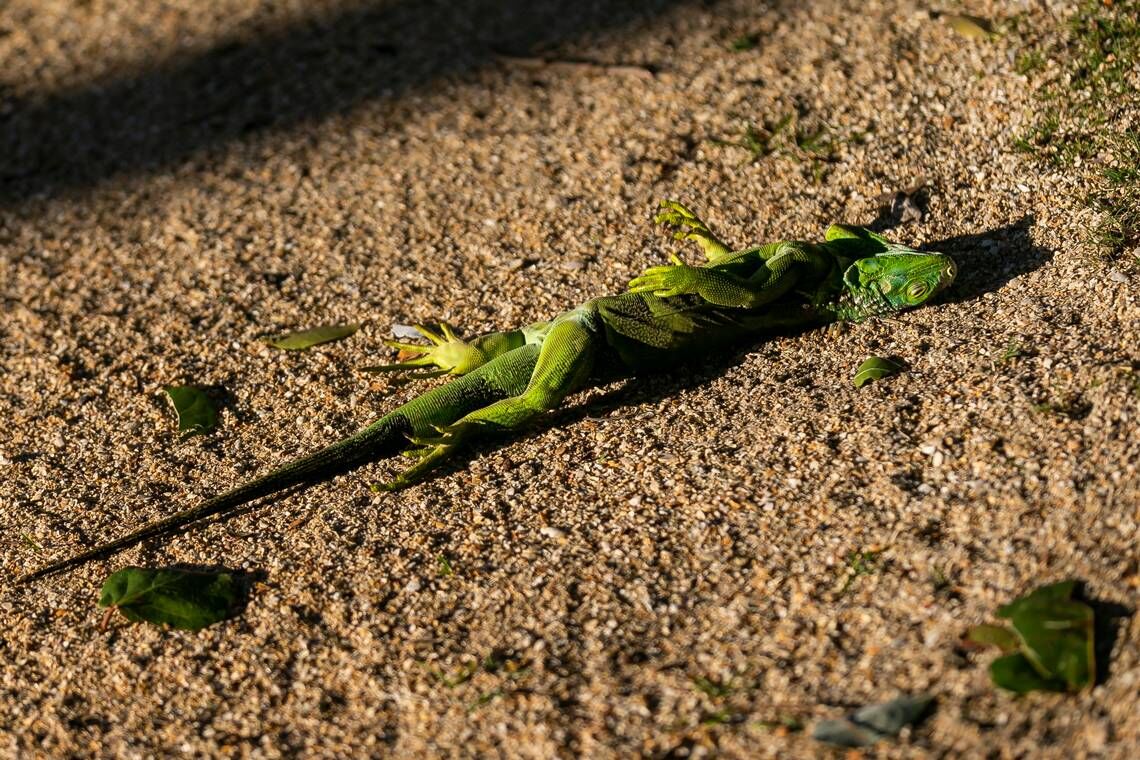Fewer falling iguanas in Florida’s future? They may be adapting to cold
Alongside runs on hot chocolate and churros, cold-stunned iguanas dropping from trees are one of South Florida’s most iconic winter traditions.
When it gets cold, videos of the reptiles sprawled on the ground pop up all over social media, including during the recent Christmas cold snap that plunged temperatures into the 40s near Miami.
But ongoing research suggests Florida’s falling iguana phenomenon could be rarer in the future — both due to climbing global temperatures from unchecked climate change and a shift in cold hardiness in the lizards themselves. That’s right, the big lizards (cue the sci fi movie music) appear to be adapting.
That’s a bummer for anyone hoping that the latest prolonged dip into colder temperatures could help knock back the rapidly growing population of exotic reptiles that rank among the state’s most damaging invasive creatures.
Iguanas are more than a garden and landscape-chomping nuisance in South Florida. They can carry infectious bacteria like salmonella, devour endangered plants and animals and undermine seawalls and canal banks. On at least one recent occasion, a rogue iguana in search of a snack also knocked out power to an entire city. It wasn’t the first time one had fried an electrical system.
When temperatures drop, cold-blooded reptiles like iguanas lose the ability to control their muscles, sending them raining down from the trees they call home or unable to respond to the pokes and prods from curious humans.

MATIAS J. OCNER
An iguana is seen lying on the ground in Miami Beach as temperatures dipped into the low 40s and upper 30s on Jan. 22, 2020.
Once they warm up, they typically snap out of their stupor. But prolonged exposure or freezing temperatures can be fatal, and biologists have long pointed to frigid snaps as the only realistic hope for curbing the population boom. Recent research suggests it may need to get a lot colder than it did over the holidays. How much and how long is a still-unanswered question.
James Stroud, a postdoctoral research associate at Washington University in St. Louis, found that most of South Florida’s most common lizard species are able to withstand slightly lower temperatures than they could even just four years earlier — a drop of about 2 degrees Fahrenheit, according to a 2020 paper published in the journal Biology Letters.
“What we saw is every one of these different types of lizards, they could now move at much colder temperatures than they did before,” he said.
Lizards in coolers
For professional iguana hunter Steve Kavashansky, that checks out.
Speaking from Miami Beach, where his company, Iguana Busters, has one of several contracts to eradicate the invasive reptiles, Kavashansky said he’s getting fewer calls after a cold snap to deal with dead or stunned iguanas.
“Cooler weather that in years past would have stunned the iguanas, we’re not seeing that now,” he said. “We used to get calls all the time. Over the years we’ve seen those calls decrease because they’re getting acclimated.”
Kavashansky said he’s also heard reports of iguanas appearing as far north as Orlando, which could validate researchers’ theory that iguana populations may move north as they get used to slightly colder temperatures.
Stroud’s study found the magic number for all seven species they looked at was about 44 degrees Fahrenheit. At that point, most South Florida lizards freeze up.
Discovering that number involved packing lizards into an ice-filled cooler and monitoring their internal body temperature over the hour or so it took to cool them down. For the original 2020 study, the coolers were too small for iguanas, so they weren’t included, but Stroud said that they’ve since upgraded to iguana-sized coolers and folded the reptiles into their research.
After the lizards are revived in warmer temperatures, they’re tagged and released back into the wilds of Fairchild Botanical Garden in Coral Gables, Florida, so Stroud and his team can run similar tests on them in the future.
But because researchers didn’t kill them, they’re not sure exactly what kind of cold is lethal for lizards.
“That’s one of the biggest questions we don’t know. We don’t know if it’s prolonged exposure to these temperatures that’s more harmful or one big cold snap,” he said.
